-
Welcome back Guest! Did you know you can mentor other members here at H-M? If not, please check out our Relaunch of Hobby Machinist Mentoring Program!
You are using an out of date browser. It may not display this or other websites correctly.
You should upgrade or use an alternative browser.
You should upgrade or use an alternative browser.
DIY heavy duty PM-833 CNC conversion
- Thread starter buzzfab
- Start date
- Joined
- Feb 24, 2022
- Messages
- 30
The X is done.. well the printed prototype is, here is a video of it in motion.
Its very tight to get in and out but I have done it a few times now and it get easier every time. It looks like I roughly get 575-600mm of travel, the limit is the hard oil lines. They are connect to drilled holes in the castings, where the feed oil to the ways and are physically in the way. you can see the aluminum line bend and go down into the casting this first picture.

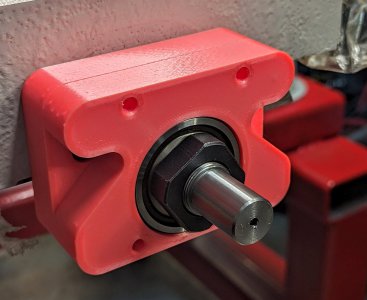
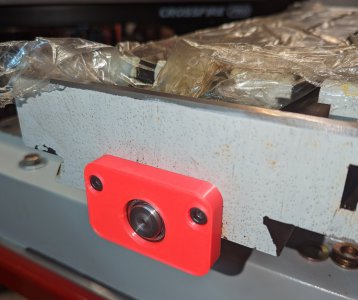
The Z parts are printing as I type but wont be done in time for me to do anything with them today
I am still waiting for motors to arrive but have been informed they are in transit.
Eric
Its very tight to get in and out but I have done it a few times now and it get easier every time. It looks like I roughly get 575-600mm of travel, the limit is the hard oil lines. They are connect to drilled holes in the castings, where the feed oil to the ways and are physically in the way. you can see the aluminum line bend and go down into the casting this first picture.



The Z parts are printing as I type but wont be done in time for me to do anything with them today
I am still waiting for motors to arrive but have been informed they are in transit.
Eric
- Joined
- Feb 24, 2022
- Messages
- 30
I finished prototyping with printed parts last week sometime but I have been super busy with work to get anything else done. All the motion is smooth for the full motion of all axis. Here are some pic of the Z parts.
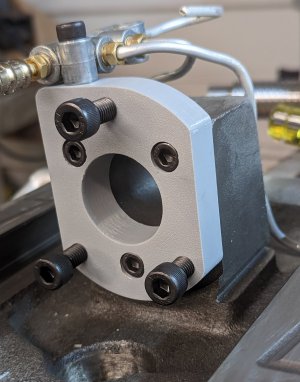
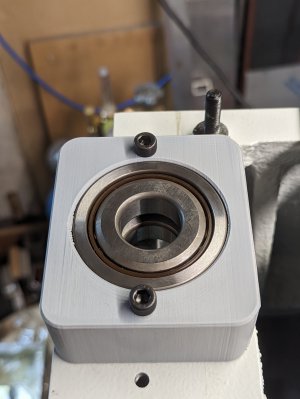
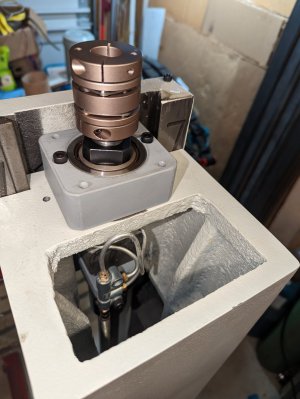
I am still waiting for the servo drives and motors to arrive but I picked up some other electrical components like an Eaton 60a mini circuit breaker, a 60a AC Contactor, AC noise filter which are recommended for the install. I picked up some 26-pin SCSI BOBs for connecting the I/Os on the ethercat drives and 1 meter cables for each to add some distance from the high voltage lines for minimize noise.
I have been thinking about how to control the stock VFD with linux-cnc. I tried to get some information from Precision Matthews about it but they claim "It's a proprietary board from the vendor" and wont share anything. The stock controller board is labeled DYNA-06 ver. 1820 but I can't find anything online. I can see its 12v controlled instead of the standard 0-10v like a standard vfd which makes it a little more difficult. Worst case scenario I guess is a digital pot or DAC controlled via arduino or something like that but I want to avoid USB if I can. I do already own a couple or import HY VFDs that could easily be swapped in but I want to try an use the one that comes it with first.
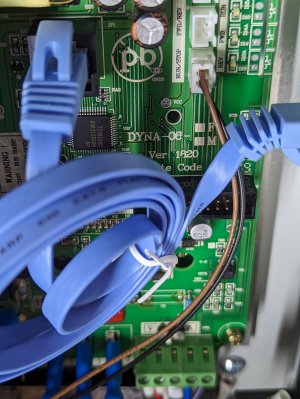
Some things I have noticed about the construction of my PM833-TV which I assume is similar to others.
The Holes - like wtf did a child locate and drill them? some many holes drill off axis, not evenly spaced or on angles its ridiculous. have they never hear of jigs or drill guides?
The Tapping - More than a few have been "double tapped" part way into a hole at the wrong angle then backed out and retapped at a different angle, so you need to be mindful when starting your screws to not cross thread. I found it best to take a counter sink to all the holes and deburr them all.
The Ways - They claim to be hand scrapped but they are not. In photos and from a distance the look to be hand scrapped be when you get close you see that that hand scrapping is sparse and superficial. The scrapping is also only on the surfaces that are visible when fully assembled and still those surfaces are mostly ground but machining marks are still visible. This is the Z axis but the rest look similar.
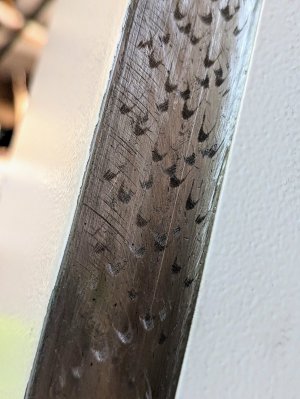
When you take it apart you will notice that all the non visible part of the way are just ground with no visible hand scraping at all. I would descibe the grind job on these areas as poor at best.. like look at the ways from the both slides with tool marks and visible gouging that was never cleaned up. its actually rough in spots and I will stone everything before final assembly
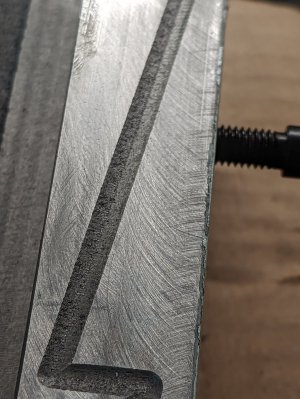
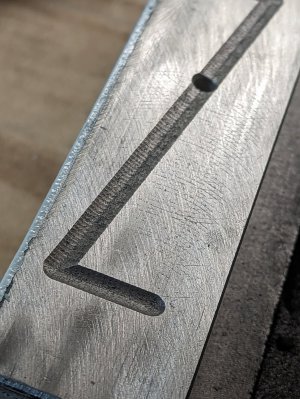
The worst part was that it arrived with rust growing on the non visible parts that left pitting on the bed ways, this was super disappointing to see on a brand new machine what was still in the crate. it seams with as much grease it came layered in they missed some of the important spots.
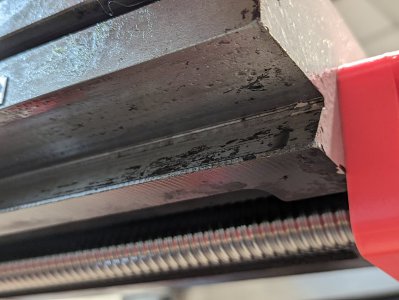
I don't have a non Taiwanese machine like a pm932v to compare it to but imagine it cant be much worse. I wonder if the premium price is worth it
Anyway just some thoughts
Eric



I am still waiting for the servo drives and motors to arrive but I picked up some other electrical components like an Eaton 60a mini circuit breaker, a 60a AC Contactor, AC noise filter which are recommended for the install. I picked up some 26-pin SCSI BOBs for connecting the I/Os on the ethercat drives and 1 meter cables for each to add some distance from the high voltage lines for minimize noise.
I have been thinking about how to control the stock VFD with linux-cnc. I tried to get some information from Precision Matthews about it but they claim "It's a proprietary board from the vendor" and wont share anything. The stock controller board is labeled DYNA-06 ver. 1820 but I can't find anything online. I can see its 12v controlled instead of the standard 0-10v like a standard vfd which makes it a little more difficult. Worst case scenario I guess is a digital pot or DAC controlled via arduino or something like that but I want to avoid USB if I can. I do already own a couple or import HY VFDs that could easily be swapped in but I want to try an use the one that comes it with first.

Some things I have noticed about the construction of my PM833-TV which I assume is similar to others.
The Holes - like wtf did a child locate and drill them? some many holes drill off axis, not evenly spaced or on angles its ridiculous. have they never hear of jigs or drill guides?
The Tapping - More than a few have been "double tapped" part way into a hole at the wrong angle then backed out and retapped at a different angle, so you need to be mindful when starting your screws to not cross thread. I found it best to take a counter sink to all the holes and deburr them all.
The Ways - They claim to be hand scrapped but they are not. In photos and from a distance the look to be hand scrapped be when you get close you see that that hand scrapping is sparse and superficial. The scrapping is also only on the surfaces that are visible when fully assembled and still those surfaces are mostly ground but machining marks are still visible. This is the Z axis but the rest look similar.

When you take it apart you will notice that all the non visible part of the way are just ground with no visible hand scraping at all. I would descibe the grind job on these areas as poor at best.. like look at the ways from the both slides with tool marks and visible gouging that was never cleaned up. its actually rough in spots and I will stone everything before final assembly


The worst part was that it arrived with rust growing on the non visible parts that left pitting on the bed ways, this was super disappointing to see on a brand new machine what was still in the crate. it seams with as much grease it came layered in they missed some of the important spots.

I don't have a non Taiwanese machine like a pm932v to compare it to but imagine it cant be much worse. I wonder if the premium price is worth it
Anyway just some thoughts
Eric
I’m very interested to hear how this project is going. Is the machine working yet?
Also, I’m confused on your X-axis. You show a photo where you lopped off the bearing support on the ballscrew, but later you have a photo of the finished X-axis and it shows supports on both ends. What am I misunderstanding?
Also, I’m confused on your X-axis. You show a photo where you lopped off the bearing support on the ballscrew, but later you have a photo of the finished X-axis and it shows supports on both ends. What am I misunderstanding?
- Joined
- Feb 24, 2022
- Messages
- 30
Update, I finished the prototype parts for the Z a few weeks back and then had to pause the project because work was getting in the way.
Here is little video of it moving
Some photos
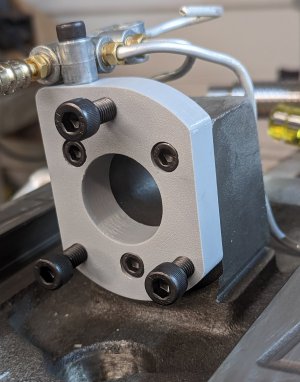
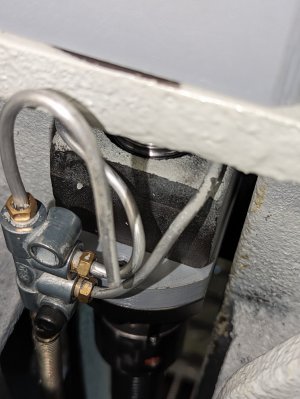
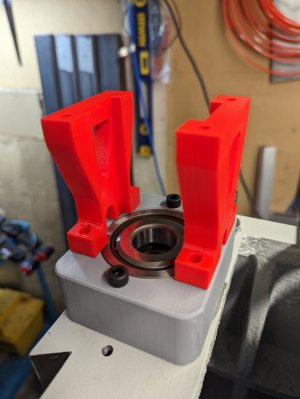
Because the Ballscews need lube I have decided to stick with oil instead of grease so I need to replace the zerk fitting with push-to-connect 4mm 90 degree fitting. I picked these plated brass ones up from mettleair with some 4mm line. I also grabbed a small manifold from ebay that has adjustments on each output so I can control how much oil goes to each line.
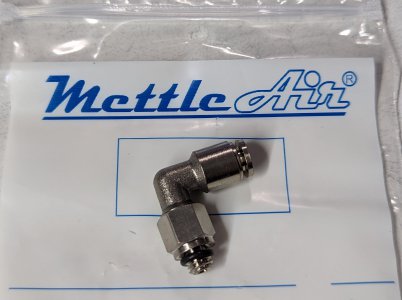
I need to make the parts from aluminum still but I will be moving on to bench testing the Motors and Drives first. I actually started but will save that info for the next post.
For the control software I planned on running LinuxCNC on a HP EliteDesk 800 35W G2 Desktop Mini PC I already owned but OrangePi just released a OPi5+ and I would rather use it so I can embed it in my controller box. It was just released last week, I ordered it on the first day it became available and it hasn't shipped yet from china so it could be a bit still. Also its so new they haven't even got a operating system image for it yet never mind a real time kernal but I'm sure it will all get figured out soon enough. I also want this board because its has dual onboard 2.5gb ethernet ports which will allow Ethernet and EtherCat at the same time and it runs of a standard 12v PSU.
@3Dogs... Thanks for reading my build log. Sorry for the confusion I didn't even notice my mistake, thanks for pointing it out.. The Y ballscrew was the one that I chopped the end off, It is the shortest of the 3 and is unsupported on the one end. Do you have one of these mills and if so do you plan to convert it to CNC?
My next update wont take so long next time.
Eric
Here is little video of it moving
Some photos



Because the Ballscews need lube I have decided to stick with oil instead of grease so I need to replace the zerk fitting with push-to-connect 4mm 90 degree fitting. I picked these plated brass ones up from mettleair with some 4mm line. I also grabbed a small manifold from ebay that has adjustments on each output so I can control how much oil goes to each line.

I need to make the parts from aluminum still but I will be moving on to bench testing the Motors and Drives first. I actually started but will save that info for the next post.
For the control software I planned on running LinuxCNC on a HP EliteDesk 800 35W G2 Desktop Mini PC I already owned but OrangePi just released a OPi5+ and I would rather use it so I can embed it in my controller box. It was just released last week, I ordered it on the first day it became available and it hasn't shipped yet from china so it could be a bit still. Also its so new they haven't even got a operating system image for it yet never mind a real time kernal but I'm sure it will all get figured out soon enough. I also want this board because its has dual onboard 2.5gb ethernet ports which will allow Ethernet and EtherCat at the same time and it runs of a standard 12v PSU.
@3Dogs... Thanks for reading my build log. Sorry for the confusion I didn't even notice my mistake, thanks for pointing it out.. The Y ballscrew was the one that I chopped the end off, It is the shortest of the 3 and is unsupported on the one end. Do you have one of these mills and if so do you plan to convert it to CNC?
My next update wont take so long next time.
Eric
Thanks for updating us on the progress.
Do you think the printed supports are strong enough to have the mill machine the final ones out of aluminum? That would be nifty!
I am doing research right now. I’m leaning towards getting the PM-833TV, and the Arizonavideo CNC conversion. He’s local, so I might drive over and talk in person. I am creating a list of items that need to be purchased, and trying to source the expensive ones (like the motors - I think I’m going to use servos).
Do you think the printed supports are strong enough to have the mill machine the final ones out of aluminum? That would be nifty!
I am doing research right now. I’m leaning towards getting the PM-833TV, and the Arizonavideo CNC conversion. He’s local, so I might drive over and talk in person. I am creating a list of items that need to be purchased, and trying to source the expensive ones (like the motors - I think I’m going to use servos).
- Joined
- Feb 24, 2022
- Messages
- 30
@3Dogs
For sure the 3d Printed parts are strong enough for making the few aluminum parts I need. This is my plan for the build. There is 1 part I am going to mill at work though. The Z ballscrew adapter plate, to replace that I would have to remove the spindle and oil lines to get access to it. Everything else I can get access to pretty easily but that plate is alot of work.
ArizonaCnc, Dave has a lot of experience making kits so I'm sure it will be decent. When I bought machine I reached out to Dave to see about a kit for it. At the time I was told he had no plans to make one for this model. Heavymetalcnc had one available but I didn't like the reviews and It looked under built with 20mm ballscrew and single nuts. A few months later Dave put out a video about the pm833tv, Heavymetalcnc was now defunct and he was now making a kit that would be available in few weeks. I emailed him right away, we talked a few times, I helped him with measurements because he didn't have a machine on hand. Then he just stopped replying which I found unprofessional.
At that point I had the machine disassembled for 9 months and I decided it was time to get this project moving. I whipped up the CAD in a week and have been chipping away on it ever since.
Don't believe his story about his "zero backlash" ballscrews. They are just cheap import ballscrews with oversized ballbearings. They will not compare to a THK/Steinmeyer/NTN or any actual quality made product no matter how much he "reworks them".
I should have just done it myself from the start.
Oh well.
Eric
For sure the 3d Printed parts are strong enough for making the few aluminum parts I need. This is my plan for the build. There is 1 part I am going to mill at work though. The Z ballscrew adapter plate, to replace that I would have to remove the spindle and oil lines to get access to it. Everything else I can get access to pretty easily but that plate is alot of work.
ArizonaCnc, Dave has a lot of experience making kits so I'm sure it will be decent. When I bought machine I reached out to Dave to see about a kit for it. At the time I was told he had no plans to make one for this model. Heavymetalcnc had one available but I didn't like the reviews and It looked under built with 20mm ballscrew and single nuts. A few months later Dave put out a video about the pm833tv, Heavymetalcnc was now defunct and he was now making a kit that would be available in few weeks. I emailed him right away, we talked a few times, I helped him with measurements because he didn't have a machine on hand. Then he just stopped replying which I found unprofessional.
At that point I had the machine disassembled for 9 months and I decided it was time to get this project moving. I whipped up the CAD in a week and have been chipping away on it ever since.
Don't believe his story about his "zero backlash" ballscrews. They are just cheap import ballscrews with oversized ballbearings. They will not compare to a THK/Steinmeyer/NTN or any actual quality made product no matter how much he "reworks them".
I should have just done it myself from the start.
Oh well.
Eric
Last edited:
- Joined
- Feb 24, 2022
- Messages
- 30
Would you be interested in making another set of supports and selling them to me?
And, letting me know where you bought your screws and bearings?
I haven't even finished with my own build yet, so there is no way I could commit to something like that at this point. The last thing I would want to do is string you one and make you wait for months as I know what that feel like. When I have completed my build it could be something I do, supply the machined parts and the details on the bearings and ballscrews.
If it was me buying a kit I would prefer the option of buying only the machined parts so I could choose what kind of brand/quality the bearing and ballscrews are. I bought these rolled C7 ballscrews from HLTNC on aliexpress, but I definitely should have just saved for some proper C3 ground ones from Japan or Germany or even here where I am in Canada. NTN has a Canadian location. I will have to upgrade one day when these wear out. A common problem with these cheap rolled ballscrews is that for example, a 2005 ballscrew is 20mm wide and each rotation should be exactly 5mm of linear travel. in the real world non of the rotations are a perfect length. A 10 rotation section which should add up to 50.000mm might end up being 50.034mm and the next section 49.989mm. They show up with backlash from the factory, you could "rework them" by swapping out the balls or if you have a double length nut you can add a shim between both nuts to add some pressure on the BBs but nothing is going to get rid of the inherent problems that cheap ballscrews are "born" with.
Who knows though by the time you get the machine in your possession I could be finished. My advice though if you are going to convert any mill to cnc is to get the controller, safety relay, software, power, terminals, AC noise filters, motors, drives, contactors, relays, e-stop, limit switches and any other electrical components bench tested before you ever start on the mechanical side of the build. the mechanical side is straight forward and can be done in a few days with all the parts in hand. The electronics could take you months to figuring out what you want to use, how to lay them out to fit in a cabinet, then finding a cabinet that actually fits everything that doesn't cost more than the motors themselves.
This isn't my first machine retrofit so I had an idea of what i was getting into but the price of a lot of these items had risen drastically and they harder to get due to ongoing supply chain issues.
Eric
Thanks!
I have no idea how close I am to getting the mill. I’ll track your progress and stay in touch.
One thing that I’ve already come across - the AZvideo kit (and, I suspect most other conversion kits) are sized for NEMA 34 motors, but I am leaning towards using a less expensive Chinese servo, and those have a different frame size (80 or 90 mm). The bolt pattern is close, but not close enough. If I bought one of those kits, I would probably put it on my manual mill and slot the existing holes at 45° to match the metric servo mounting pattern. I suspect that would work, and if I was careful, wouldn’t add too much shaft offset.
I have no idea how close I am to getting the mill. I’ll track your progress and stay in touch.
One thing that I’ve already come across - the AZvideo kit (and, I suspect most other conversion kits) are sized for NEMA 34 motors, but I am leaning towards using a less expensive Chinese servo, and those have a different frame size (80 or 90 mm). The bolt pattern is close, but not close enough. If I bought one of those kits, I would probably put it on my manual mill and slot the existing holes at 45° to match the metric servo mounting pattern. I suspect that would work, and if I was careful, wouldn’t add too much shaft offset.

